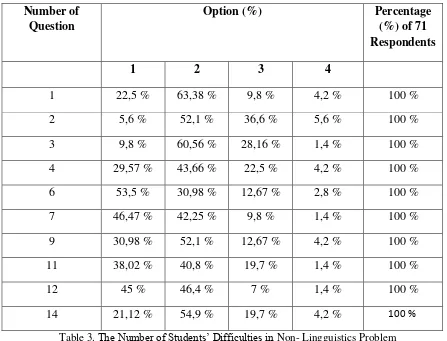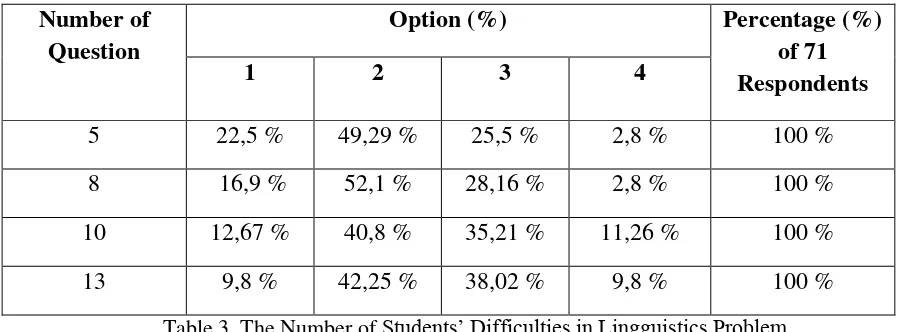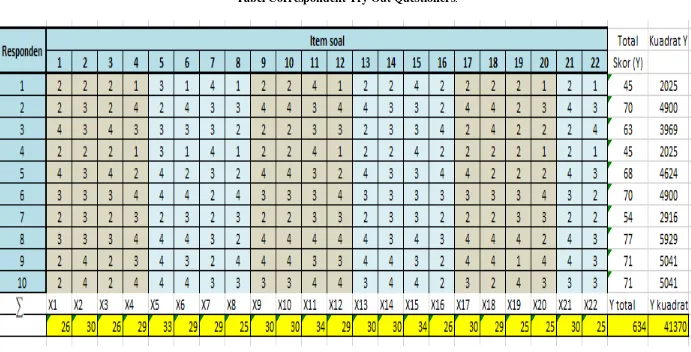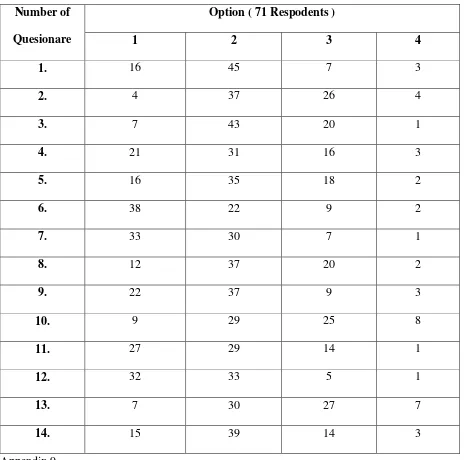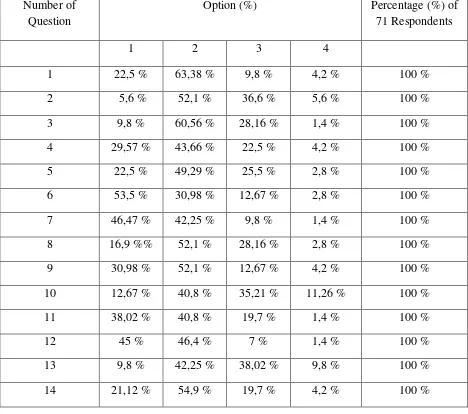27 CHAPTER IV
RESULTS AND DISCUSSION
In this chapter, the researcher will describe the finding of the research. The findings
would be divided in to two parts; the linguistics factors and non linguistics factors.
Furthermore, the researcher will describe in details what aspects or items of the two factors
above. Afterthat, the researcher will describe the reason why those findings were found in
discussion session.
4.1 Results
The percentage of the students’ difficulties in translating English texts into Bahasa
Indonesia could be seen in this table below:
28
Table 1.The Number of Students’ Difficulties in Lingguistics and Non-Linguistics Problems
In general the result of this research is described as follows. The first one is from the
linguistic factors. From the table above, the researcher found that there was a problem in
translating English text in to Bahasa Indonesia on the linguistic and non linguistic factors.
1. The difficulty in translation related to the ideology values was 22,5%
2. The difficulty in translation related to the cultural values was 6,6%
3. The difficulty in translation related to the historical value was 9,8%
4. The difficulty in translation related to the social politic value was 29,57%
5. The difficulty in translating phrase was 22,5 %
6. The difficulty in translation related to the chemical value was 53,5%
7. The difficulty in translation related to the technical value was 46,47%
8. The difficulty in translating complicated English sentences was 16,9%
9. The difficulty in translation related to the biologycal value was 30,98%
10. The difficulty in difference structure between English and Bahasa Indonesia was
12,67%
11. The difficulty in translation related to the agricultural value was 38,02%
12. The difficulty in translation related to the medical value was 45%
13. The difficulty in understanding the meaning from the source language was 9,8%
14. The difficulty in translation related to the economical values was 21,12%
From the table above, the researcher found that there was a problem in translating
English text in to Bahasa Indonesia on the non linguistic factors. The biggest difficulty that
was encountered by the students in translating English text in to Bahasa Indonesia text was
29 encounter the difficulty. The second one was the difficulty in translating on the technique
value was 46,47% equal to 33 out of 71 students or respondents who encounterd the difficulty
in this side. This findings was also in line with the result or findings when the researcher
deployed interview. The students encounterd difficulty in translating text in chemical value
because those students did not understand the terms used in this field. There were 45% equal
to 32 students encountered the difficulty in translating the English text in to Bahasa Indone
sia on the medical value. More over, the researcher also found the same thing on one of the
interview respondent that the respondent encountered the difficulty in the medical values
because of the absent of knowledge in the medical terms. On the other hand, In linguistic
factors, the researcher found the biggest difficulty that was encountered by the student in
translating English text into Bahasa Indonesia text was problem in translating about phrases
was 22,5% equal to 16 out 71 student or respondents.
In detail, the researcher will describe the result of the research in to two parts; non
linguistic and linguistic factors. The first one is in the non linguistic factors. Item
questionnaire number 6. “Saya mengalami kesulitan dalam menerjemahkan kata-kata yang
berhubungan dengan nilai-nilai Kimia” From the table above, showed that 53,5% or 38 of 71
respondents chose option 1(sering), and 30,98 % or 22 of 71 respondents chose option 2
(kadang-kadang) . It was a high number of the students’ difficulties in translating words that
related to chemistry value. This case was caused by the knowledge and the understanding of
the students about chemistry value in translating was still less. It can be seen more through
30
Table 3. The Number of Students’ Difficulties in Non- Lingguistics Problem
Item questionnaire number 1.” Saya mengalami dalam menerjemahkan kata-kata yang
berhubungan dengan nilai-nilai ideologi.” From the table above, showed that 22,5% or 16 of
71 respondent chose option 1 (sering) and 63,38% or 45 of 71 respondents chose option 2
(kadang-kadang). It was a high number of the students’ difficulties in translating word related
to ideology value. This case was caused by the knowledge and the understanding of the
students about ideology value in translating was still less.
Item questionnaire number 2. “Saya mengalami kesulitan dalam menerjemahkan kata
-kata yang berhubungan dengan nilai-nilai budaya”. From the table above, showed that 5,6 %
or 4 of 71 respondent chose option 1 (sering) and 52,1 % or 37 of 71 respondents chose
option 2 (kadang-kadang). It was a high number of the students’ difficulties in translating
words that related to culture value. This case was caused by the knowledge and the
31 Item questionnaire number 3. “Saya mengalami kesulitan dalam menerjemahkan kata
-kata yang berhubungan dengan nilai-nilai sejarah”. From the table above, showed that 9,8%
or 7 of 71 respondent chose option 1 (sering), and 60,56% or 43 of 71 respondents chose
option 2 (kadang-kadang). It was a high number of the students’ difficulties in translating
words that related to historical value. This case was caused by the knowledge and the
understanding of the students about historical value in translating was still less.
Item questionnaire number 4. “Saya mengalami kesulitan dalam menerjemahkan kata
-kata yang berhubungan dengan nilai-nilai Sosial-Politik.”. From the table above, showed that
9,57% or 21 of 71 respondent chose option 1 (sering) and 43,66% or 31 of 71 respondents
chose option 2 (kadang-kadang). It was a high number of the students’ difficulties in
translating words that related to political-social value. This case was caused by the
knowledge and the understanding of the students about political-social value in translating
was still less.
Item questionnaire number 7. “Saya mengalami kesulitan dalam menerjemahkan kata
-kata yang berhubungan dengan nilai-nilai Teknik.” From the table above, showed that
46,47% or 33 of 71 respondents chose option 1 (sering) and 42,25% or30 of 71 respondents
chose option 2 (kadang-kadang). It was a high number of the students’ difficulties in
translating words that related to technical value. And There was a significant similarity
between option 1 and 2.
Item questionnaire number 9. “Saya mengalami kesuliatan dalam mmenerjemahkan
kata-kata yang berhubungan dengan nilai-nilai Biologi.” From the table above, showed that
30,98% or 22 of 71 respondent chose option 1 (sering) and 52,1% or 37 of 71 respondents
32 translating words that related to biology value. This case was caused by the knowledge and
the understanding of the students about biology value in translating was still less.
Item questionnaire number 11. “Saya mengalami kesulitan dalam menerjemahkan
kata-kata yang berhubungan dengan nilai-nilai pertanian.” From the table above, showed that
38,02% or 27 of 71 respondents chose option 1 (sering) and 40,8% or 29 of 71 respondents
chose option 2 (kadang-kadang). It was a high number of the students’ difficulties in
translating words that related to agricultural value. There was a significant similarity between
option 1 and 2. This case was caused by the knowledge and the understanding of the students
about agricultural value in translating was still less.
Item questionnaire number 12. “Saya mengalami kesulitan dalam menerjemahkan
kata-kata yang berhubungan dengan nilai-nilai Kedokteran.” From the table above, showed
that 44% or 32 of 71 respondents chose option 1 (sering) and 46,4% or 33of 71 respondents
chose option 2 (kadang-kadang). It was a high number of the students’ difficulties in
translating words that related to medical value. There was a significant similarity between
option 1 and 2. This case was caused by the knowledge and the understanding of the students
about medical value in translating was still less.
Item questionnaire number 14. “Saya mengalami kesulitan dalam menerjemahkan
kata-kata yang berhubungan dengan nilai-nilai Ekonomi.” From the table above, showed that
21,12 % or 15 of 71 respondent chose option 1 (sering) and 54,9% or 39 of 71 respondents
chose option 2 (kadang-kadang). It was a high number of the students’ difficulties in
translating words that related to economics value. This case was caused by the knowledge
and the understanding of the students about economics value in translating was still less.
Second one is the result from the linguistic factors. Item number 5 “Saya mengalami
33
Table 3. The Number of Students’ Difficulties in Lingguistics Problem
Item questionnaire number 8 “Saya menemukan pola kalimat bahasa inggris yang
berbelit–belit sehingga menyulikan saya dalam menerjemahkanya kedalam bahasa
indonesia”. From the table above, shows that 16,9% or 16 of 71 respondent chose option 1
(sering), and 52,1% or 37 of 71 respondents chose option 2 (kadang-kadang). It was a high
number of the students’ difficulties in translating wind sentences English into Bahasa
Indonesia. This case was caused by the knowledge of the students in understanding the
purpose of the wind sentences in English was still less.
Item questionnaire number 10 “Saya menemukan perbedaan strukture Bahasa
Indonesia dengan struktur Bahasa Inggris sehingga menyulitkan saya dalam
menerjemahkanya” . From the table above, shows that 12,67% or 10 of 71 respondent chose
option 1 (sering) and 40,8% or 29 of 71 respondents chose option 2 (kadang-kadang). It was a
high number of the students’ difficulties in translating the English text that has different
34 understanding the of the students about the structure of English and Bahasa Indonesia was
still less.
Item questionnaire number 13,” Saya mengalami kesulitan dalam memahami maksud
bahasa sumber ( Bahasa Inggris ) sehingga menyulitkan saya menerjemahkanya ke bahasa
sasaran ( Bahasa ndonesia)”. From the table above, shows that 9,8% or 7 of 71 respondent
chose option 1 (sering) and 42,25% or 30 of 71 respondents chose option 2 (kadang-kadang)
and it was a high number of the students’ difficulties in translating English text into Bahasa
Indonesia. This case was caused by the understanding of the student about the purpose
Source language into Target Language.
In bref, in can be concluded that the students encounter difficulty more in the non
linguistic factors, especially when dealing with chemical values, technical values and medical
values. On the otherside, the students also encountered minor difficulty in linguistic factors
especially in dealing with phrase in a sentence. Therefore, the non lingusitic factors is more
prominent problem than the non linguisitc factors.
1.2Discussion
Based on the previous result, the researcher found that the students encountered more
difficulties in the non linguistic factors, especially in dealing with the chemical values,
technical values and medical values. This case was caused by the knowledge and
understanding of the student about chemical values, technical values and medical values in
translating was still less. Meanwhile, in the linguistic factors, the students encountered
difficulty with phrase.
This findings is different from the research conducted by Rahayu (2002 ) entitled “
35 Universitas Bengkulu in the Academic Year 2001/2002)”. This researcher used descriptive
method and collected the data by using translation test. The population in this research was
only 33 students of English Education Study Program UNIB in academic years 2001-2002.
The finding shows that 63,6 % students had difficulties in translating simile sentences where
the translating simile is categorized as linguistic factors. It happened due to the reason that
the student did not know the suitable techniques for translating the idiom especially English
simile, and the students do not learn the idiom specifically. This difference happened because
of the different instruction with in each research. The research done by Rahayu (2002) asked
the students to translate text that had been conditioned as simile only without inserting other
things related to the nonlinguistic factors. As the result the difficulty that was found was only
about the simile text.
On the other hand this research is similar to the research conducted by Julia Eka Rini
(2007) entitled “Difficulties in Translating Texts for Beginner Translator Student “. By
asking the students in English Department of Petra Christian University to translate English
text, the researcher found that students had difficulties in understanding the text and
restructuring it into good Indonesian language. The ability to transfer the meaning of one
language to other language correctly is dependent to the nonlinguistic factors. This similarity
happened because the subject of both researches were in the quiet similar category. Both of
the subjects were still beginner translators in translation field. They had very little experience
in translating the meaning of words form one language to another language by including the
semantic and pragmatic meaning. To do this both of the subjects need background knowledge
of specific fields dealing with what they are translating. They need chemistry background
knowledge when translating texts that specifically deal with that domain.
Finally, the finding of this research is also similar to the one conducted by Sari
36 Idioms Into Bahasa Indonesia (A Study at the Sixth Semester students of the English Study
Program in the Academic Year of 2009/20010) aiming at investigating the students’ errors
and their strategies in translating English Verbal idioms into Bahasa Indonesia with the
population of the research was 25 students and the data were collected by using translating
test, it was found that the students had difficulties in finding out the suitable terms with the
context of the sentences. Most of them translated the English verbal idioms without
concerning on the suitable meaning with the idioms without of the target language. This is
because of the nonlinguistic factors. This similarity existed because of the lack of the context
of the text that they needed to have in translating. This ability was influenced more by the
37 CHAPTER V
CONCLUSIONS AND SUGGESTIONS
5.1Conclusions
After conducting the research and doing data analysis, the researcher derived
conclusion in this two following points:
1. It was found that sixth semester of English Department students of University
Bengkulu in academic year 2011/2012 had difficulties in translating English texts
into Bahasa Indonesia that were far more influenced by the nonlinguistic factors.
The chemical values was the most prominent factors among technical values and
medical values that caused the students having difficulties in translating the text.
2. Although the nonlinguistic factors were the most prominent factors that appear
sixth semester of English Department students of University Bengkulu in
academic year 2011/2012 in translating English texts into Bahasa Indonesia, the
linguistic factors also contributed in minor way to the difficulties in the translation
38 5.2Suggestions
There are some suggestions that the researcher can propose after doing the analysis
as follows:
1. The lecture give various practices about Linguistics and Non-Linguistics
knowledge in translation class.
2. The lecture should search more information about linguistic and non-linguistic
problem in translation by browsing in the internet or finding some books that are
about translation.
3. It is expected that there will be further research that will investigate more
difficulties in translating English texts into Bahasa Indonesia, especially the
students’ difficulties in translating English related to medical, technical,
ideological and chemical text.
4. The researcher just studies four Students’ Difficulties in Translating English Text
in to Bahasa Indonesia. It suggested to other researcher to investigate the
39 REFERENCES
Anthony Ferry. Menterjemahkan dari Bahasa Indonesia ke Dalam Bahasa Inggris:Masalah dan Tantangan. http://www.geocities .com/ferryaar/intro.html.
Arikunto , Suharsimi. (1998). Procedure Penelitian Suatu pendekatan praktek. Jakarta : Rineka Cipta.
Ashshofa, B. (2007). Metode Penelitian Hukum. Jakarta: Rineka Cipta
Burdah , ibnu. (2004). Menjadi Penerjemah. Yogyakarta: Tiara Wacana
Catford, J. C .( 1965) A linguistic theory of translation , Oxford : Oxford university Press,
Djuharie. O. Setiawan. (2004). Teknik dan panduan menterjemahkan : Bahasa Inggris – Bahasa Indonesia . Bandung. Yrama Widya.
Hatim, Basil and Jeremy Munday (2004) : Translation an advanced Resouorce Book. London:Routledge.
Johan, Ghani. (2009). Reading and translation. Yogyakarta :Pustaka Pelajar.
Larson , Mildred L (1989), Meaning _ Based Translation : A guide to Cross - Language equivalence,University Press of America
Nawawi, H and Martini, M. (1994). Penelitian Terapan. Yogyakarta: Gajah Mada Universitas Press.
Newmark, Peter (1988). A Texbook of Trslation, New York : Prentice hall.
Nida, Eugene A. & Taber Charles. R (1969/1974) : The Theory and Practice of Translation , E.J . Bril. Leiden, Netherlands.
Opan . (2008). Bagaimana menterjemahkan Teks Bahasa inggris. http://www.smp1wonosobo.sch.id/content/view/24/1/.
Ordudari, Mahmoud. (1997). Translation Procedures, strategies, and methods. http://accurapid.com/journal/41culture.htm
Rahayu, tuti .(2002). Translating Similes ( A Study on the sixth Semester Student of English Study Program of Universitas Bengkulu in the Academic Year 2001/2002).
Unpublished Skripsi . Bengkulu : Universitas Bengkulu.
Riduwan.(2007). Belajar Mudah Penelitian untuk Guru dan Karyawan .Bandung: alfabeta
40 Sakri, Adjat. (1984). Ihwal Menterjemahkan. Bandung : Penerbit ITB.
Sari, Citra Amelia. (2010). An Analysis of students’ errors in Translating English Verbal Idioms Into Bahasa Indonesia (A study at the sixth Semester Students of the English Study Program in The Academic Years of 2009/2010) Unpublished Skripsi. Bengkulu Universitas Bengkulu.
Sugiono. (2011). Methode Penelitian Kuantitafi Kualitatif dan R & D. Bandung : Alfabeta
43 Appendix 1.
KISI-KISI KUISIONER
Djajanegara ( in mukhrizal, 2008 : 392 ) and Burdah ( 1984 :107) cetegoried the difficulties
into two main kinds, they are :
No. Difficulties Items
Linguistics problem Kesulitan dalam menyesuaikan kalimat yang
telah diterjemahkan kedalam bahasa indonesia
Kesulitan dalam mencari kata-kata yang tidak
tertera dalam kamus.
Kesulitan dalam menerjemahkan idiom
Kesulitan dalam menerjemahkan frase.
Kesulitan dalam menentukan arti yang tepat
pada kata-kata yang bermakna ganda.
Kesulitan dalam merangkai kata-kata dalam
bahasa sasaran.
Pola kalimat Bahasa Inggris berbelit-belit
Kesulitan menerjemahkan kalimat yang
ppanjang
Kesulitan dalam menemukan perbedaab struktur
Bahasa Indonesia dan Bahasa Inggris,
Kesulitan dalam memahami maksud bahsa
sumber ( Bahasa inggris).
Kesulitan dalam mengartikan keseluruan
44 Non- Linguistics problem Kesulitan dalam menerjemahkan kata yang
berhubungan dengan nilai-nilai budaya
Kesulitan dalam menerjemahkan kata yang
berhubungan dengan nilai-nilai sejarah.
Kesulitan dalam menerjemahkan kata yang brhubungan dengan nilai ideologi.
Kesulitan dalam menerjemahkan kaya yang
berhbungan dengan nilai-nilai politik.
Kesulitan dalam menerjemahkan kata yang
berhubungan dengan nilai- nilai kimia.
Kesulitan dalam menerjemahkan kata yang
berhubungan dengan nilai-nilai teknik.
Kesulitan dalam menerjemahkan kata yang
berhubungan dengan nilai-nilai biologi.
Kesulitan dalam menerjemahkan kata yang
berhubungan dengan nilai-nilai fisika.
Kesulitan dalam menerjemahkan kata yang berhubungan dengan nilai-nilai kedokteran.
Kesulitan dalam menerjemahkan kata yang berhubungan dengan nilai-nilai pertanian.
Kesulitan dalam menerjemahkan kata yang
45 Appendix 2.
DISTRIBUTION OF ITEMS TRY OUT QUESTIONNAIRE
No. Difficulties Items Numbers
1. Linguistic Problem 1,3,5,7,9,11,13,15,17,19,21
46
Pernyataan di bawah ini bertujuan untuk mendapatkan informasi mengenai kesulitan anda dalam menterjemahkan teks bahasa inggris kedalam bahasa indonesia.
Catatan.
1 = Sering
2 = Kadang – Kadang 3 = Jarang
4 = Tidak pernah
Bacalah setiap pernyataan berikut dengan teliti. Berilah tanda ( √ ) pada nomor yang sesuai dengan jawaban Anda.
No. Pernyataan 1 2 3 4
1. Saya mengalami kesulitan dalam menyesuaikan pola kalimat yang telah diterjemahkan dari Bahasa Inggris ke dalam pola kalimat Bahasa Indonesia.
2. Saya mengalami kesulitan menerjemahkan kata-kata yang berhubungan dengan nilai-nilai ideologi.
3. Saya mengalami kesulitan dalam mencari arti kata yang tidak tertera dalam kamus.
4. Saya mengalami kesulitan dalm menerjemahkan kata-kata yang berhubungan dengan nilai-nilai budaya. 5. Saya menemukan kata-kata yang memiliki arti ganda
sehingga menyulitkan saya dalam menentukan arti mana yang benar.
6. Saya mengalami kesulitan dalam menerjemahkan kata-kata yang berhubungan dengan nilai-nilai Sejarah. 7. Saya mengalami kesulitan dalam menerjemahkan
idiom.
8. Saya mengalami kesulitan dalam menterjemahkan kata-kata yang berhubungan dengan nilai-nilai sosial-politik. 9. Saya mengalami kesulitan dalam menerjemahkan frase. 10. Saya mengalami kesulitan dalam menerjemahkan
47 dalam Bahasa Indonesia sehingga menghasilkan kalimat
rancuh dan sulit dipahami pembaca.
12. Saya mengalami kesulitan dalam menerjemahkan kata-kata yang berhubungan dengan nilai-nilai Teknik. 13. Saya menemukan pola kalimat bahasa inggris yang
berbelit-belit sehingga menyulitkan saya dalam mnerjemahkannya kedalam Bahasa Indonesia.
14. Saya mengalami kesulitan dalam menerjemahkan kata-kata yang berhubungan dengan nilai-nilai Biologi. 15. Saya mengalami kesulitan menerjemahkan kalimat
Bahasa Inggris yang sangat panjang.
16. Saya mengalami kesulitan dalam menerjemahkan kata-kata yang berhubungan dengan nilai-nilai Fisika.
17. Saya menemukan perbedaab strukture Bahasa Indonesia dengan struktur Bahasa Inggris sehingga menyulitkan saya dalam menerjemahkanya.
18. Saya mengalami kesulitan dalam menerjemahkan kata-kata yang berhubungan dengan nilai-nilai Kedokteran. 19. Saya mengalami kesulitan dalam mengartikan
keseluruhan kalimat walaupun saya mengetahui arti per katanya
20. Saya mengalami kesulitan dalam menerjemahkan kata-kata yang berhubungan dengan nilai-nilai pertanian. 21. Saya mengalami kesulitan dalam memahami Maksud
Bahasa Sumber ( Bahasa Inggris) sehingga menyulitkan saya menerjemahkanya ke bahasa sasaran (Bahasa Indonesia)
68 Appendix 4
69 Appendix 5.
Appendix 6.
THE RESULT OF QUESTIONNAIRE VALIDITY No Item Exsplanation (Valid/Invalid)
1 Appendix 7.
Distribution Of Items Questionnaires.
No. Difficulties Items Numbers
1. Linguistic Problem 5,8,10,13
22 Appendix 8
Table of Respondents Answer the Questionnaires.
Number of Quesionare
Option ( 71 Respodents )
23
Table Result of Questionnaire
The Number of Students’ Difficulties in Lingguistics and Non-Linguistics Problems
Number of F: frequency of each items
24 Appendix 10.
The Number of Students’ Difficulties in Lingguistics Problem
Number of
The Number of Students’ Difficulties in Non- Lingguistics Problem
25 Appendix 11.
The Interview Questions
1. Apa saja kesulitan-kesulitan yang anda temukan dalam menerjemahkan sebuah teks
bahasa Inggris ke dalam bahasa Indonesia?
2. Seberapa sering anda menemukan kesulitan-kesulitan tersebut?
3. Mengapa hal tersebut menjadi kesulitan bagi anda dalam menerjemahkan teks bahasa
26 Appendix 11
The Answers of Interview Relin wahyuni
1. Kalo dalam mentranslate bahasa inggris kedalam Bahasa Indonesia jelas terdapat
kesulitan terutama dalam menterjemahkan kata-kata tersebut ke dalam konteks
sehingga kata-kata tersebut memiliki makna yang tepat dalam konteks tersebut
2. Kesulitan yang dialami tergantung pokok bahasan ,atau topik yang akan di
terjemahkan. Apakah topik itu yang umum atau spesifikasi. Kalo lebih spesipik maka
saya sering mengalami kesulitan dalam menterjemahkan kata-kata tersebut, apa lagi di
bidang saint,kodekteran atau teknologi saya sering mendapat kesulitan.
3. Karena saya di bidang Bahasa,sedangkan materi yang di berikan bukan di bidang yang
saya kuasain,maka banyak kosa kata baru yang saya dengar dan artinya juga berbeda,
Defri Azhari
1. Tentunya ada kesulitan yang saya alami ketika menterjemahkan teks Bahasa inggris ke
dalam Bahasa Indonesia.kesulitan tersebut bisa dari vocabulary yang sedikit dan kita
tidak memiliki kata-kata yang tepat untuk menterjemahkan sebuah kata atau kalimat
dalam Bahasa inggris kedalam Bahasa Indonesia.
2. Sering saya temui kesulitan ketika menterjemahkan sebuah teks atau kalimat.
3. Background knowledge kita tentang sebuah topik sangat mempengaruhi terjemahakn
27 Ramos Ade Putra
1. Kesulitan pada menterjemahkan teks bahasa ingris ke dalam bahasa indonesia bagi
saya vocabulary bng, ambo kesulitan menterjemahkan butuh menejemahkan kata
perkata,selain itu juga pada menterjemahkan ideom bang.
2. Ya gax terlalu sering bang, yang jelas jadi masalah untuk menterjemahkan teks
dengan baik am dax ngerti kadang-kadang kata-kata tu bng maknanya apa.
3. Karena saya kekuragan vocablary,dan saya kurang membaca bang,mungkin dengan
banyak membaca ha-hal baru.
Apip Kali Permana
1. Banyak megalami kendala bang,karena keterbatasan vocabulary saat menterjemahkan
jadi banyak kesulitan bang
2. Sering bang, biasanya apip kesulitan menterjemahkan di bidang keehatan susah
bang,soalnya duu waktu sma apip jurusan IPS jd idak nian ngreti istilah-istilah
kesehatan tu bang.
3. Itu kembali lagi bang,biasanya kalo vocabulary yang apip miliki banyakyang tau
biasanya lancar kalo menterjemahkan bang, tp vocabulary edikit jadi bermasalah bang
dalam mentranslate.
Dio Arisanjaya
1. Banyak bang, biasanya itu karena vocabulary yang sulit, terus teksnya tu spesifik
tentang sesuatu yang nggak familiar.
2. Kadang kadang aja bang, tergantung topiknya. Paling pas baca atikel di internet.
3. Mungkin karena vocabulary aku kurang bang, terus isilah-istilah di bidang yang nggak
28 Andri Prasitio
1. Banyak bang, karena kata yang sulit terus istilah asing dan juga kadang susah buat
kalimat yang smooth.
2. Sering bang, karena vocabulary aku kurang banyak.
3. Karena vocab kurang, terus istilahnya banyak yang nggak paham bang
Dio resta permana
1. Kesulitan mendasar yang ambo alami adalah tidak tahu arti sebuah kata bang. Dalam
menterjemahkan ada satu atau dua kata yg am dag ngerti bang,,, itu yng membuat
timbulnya kesulitan bang,,, 2) kesulitan selanjutnya mungkin kita tidak familiar
dengan cerita sebuah teks bang. Contohnya bang, teks itu tidak kontektual dengan
dilingkungan kita atau negara kita bang. Mungkin akan timbul salah mengartikan apa
maksud dari kalimat itu.
2. sering atau tidaknya tergantung tema bang. Kadang kalo temanya yg vocabnya sering
kita temui itu mudah ngerjakan bang, tpi klo temanya seperti teknik, kedokteran dll itu
sering timbul kesulitan2 bang.
3. Vocabulary adalah hal mendasar dalam menterjemahkan bang. Kalo kita kurang dalam
menguasai berbagai vocabulary itu dapat merubah arti teks, kadang kita tidak tahu
